
|   |

|   |
Sruti 30 Pattabhi Raman 80 Text & pics: Lalitha Venkat e-mail: lalvenkat@yahoo.com October 24, 2012 October 2012 is a significant month for Sruti, India’s premier magazine for the performing arts. Not only did it enter its 30th year on October 16, the 80th birth anniversary of its late Founder-Editor falls on October 24. So, it was a double celebration from October 19 to 21 at the Bharatiya Vidya Bhavan, Chennai. It was a stormy day with heavy rain flooding the roads. The evening started with a short, well made 13 minute film on 30 years of Sruti put together by Next Wave Multimedia team. It featured various Sruti covers, glimpses of significant articles, and testimonies by Aruna Sayeeram, Amritha Murali, Ritvik Raja, the Dhananjayans, Gowri Ramnarayan who reminisced about the inaugural function of the first issue and so on. The first issue of Sruti was launched by Semmangudi Srinivasa Iyer in October 1983 with DK Pattammal on the cover and the then child prodigy Mandolin Srinivas. Sruti was promoted as a not-for-profit venture and placed under a Trust in April 1985 when the Sruti Foundation was established with Founder-Editor N Pattabhi Raman as its Managing Trustee. As far back as 1998, the Sruti website was launched by Semmangudi Srinivasa Iyer. When Pattabhi Raman passed away in 2002, the question uppermost on everyone’s mind was who would take on the leadership mantle. K V Ramanathan, a retired officer of the Tamil Nadu Cadre of the Indian Administrative Service, became the next Editor-in-Chief and the magazine got by the next 4 years till in 2006, when the Sanmar Group took over Sruti and put it back on a sound footing. S Janaki, the Executive Editor of Sruti, spoke about her being with the magazine from 1989, and most of the staff for at least 10 years. Trustee Sukanya Sankar of the Sanmar Group spoke about future plans. The main challenge now is to get younger readership and a step towards that is the online version and blog. Sruti is now headed by V Ramnarayan who hopes to add audio and video content in future. Over the years the Sruti issues featured profiles of top musicians and dancers, the who’s who of the art world. Sruti’s horizon has expanded now and also features theater work, contemporary Indian dance and articles on our heritage. Making its premiere, the evening’s program was an outcome of that. 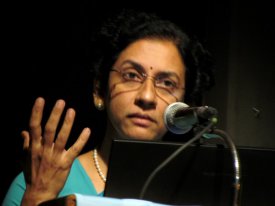 Dr. Chitra Madhavan
It was an interesting mix of lecture and slide show by historian and archaeologist Dr. Chitra Madhavan, vocal by Bharati Ramasubban and Bharatanatyam by Roja Kannan. Titled as ‘Chidambaram – Seen and Unseen,’ the focus was the temple town of Chidambaram (Thillai) and its deities, a place renowned not only for dance but music too. The pleasant backdrop designed by Thomas had a string of bilva leaves in the centre, just like in the temple’s “Chidambara rahasiyam” that denotes the formlessness (space) of the Lord. Chitra spoke about the legend and history associated with the temple, how the saints Patanjali and Vyagrahapada experienced the cosmic dance of Shiva at Chidambaram and at that very place, erected a gold domed temple to Lord Shiva. 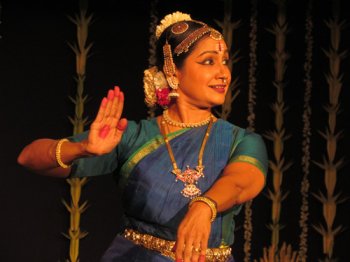 Roja Kannan The 5 sabhas of Lord Nataraja are at Chidambaram (Kanakasabhai, hall of gold), Madurai (Rajatasabhai, hall of silver), Thiruvalangadu (Ratnasabhai, hall of rubies), Thirunelveli (Tamrasabhai, hall of copper), and Kutralam (Chitrasabhai, hall of pictures). Chidambaram also has its own 5 sabhas inside the temple complex (Chit sabha, Kanaka sabha, Nritta sabha, Raja sabha and Deva sabha). Showing various sculptures of Nataraja in dancing pose, Chitra explained the Nataraja iconography in brief, pointing out the peacock feathers on top of Nataraja’s head, generally missed or mistaken for a crown. Roja then performed to “Ananda Natana Prakasam” composed by Muthuswamy Dikshitar. Narrating the story of Nandanar, Chitra said the story of the nandi moving aside to help Nandanar get a view of the Lord actually took place when he stopped at the Thirupungur temple on his way to Chidambaram and not in Chidambaram temple as is popularly believed. The illustration by artist S Rajam was beautiful. “Idhu dhano Thillai sthalam” by Gopalakrishna Bharati started with a beautiful violin and mridangam prelude and Roja performed with elegantly understated emotions. 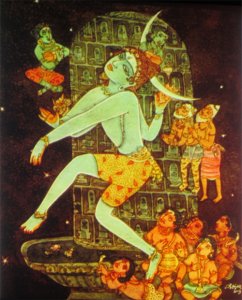 Illustration by S Rajam Chidambaram is also one of the 275 “paadal petra sthalams” that has been praised in the songs of the Nayanmars and Shiva devotees. The revered Saivite saints (7th & 8th c) Appar, Sundarar and Manikkavasagar (seen in the slide with left hand holding scripts) and Sambandar (finger pointing upwards) have sung praises of Chidambaram. Bharati sang some beautiful hymns of Sambandar. Chidambaram is also a holy place for Vaishnavites because in the Shiva temple is a sanctum for Govindarajaswami (as Rama) whose praises have been sung by Thirumangai Alwar and Kulasekara Alwar who refers to Chidambaram as Thiruchitrakootam. Bharati sang a melodious Thirumangai Alwar pasuram. Being inside the Chidambaram temple is like being in Kailasam and Vaikuntam at the same time. Worship of both deities going on side by side is very traditional yet very different from the other with respect to particular festivals, rituals, flowers, decoration etc. Roja performed to Gopalakrishna Bharati’s “Thillai Ambalathanai Govindarajanai darisikka kondeney” in Surutti ragam.  Dance sculpture with
verse inscribed on top
Chitra then elaborated on the recorded history of the temple that can be
gleaned from the various inscriptions covering much of the walls of the
temple, how the temple grew over the years into the massive edifice it
is today. Thillai Nataraja was the patron deity of the Cholas and each
ruler contributed his might to the expansion of the temple, some more
than others. The golden roof was built first, gopurams were built much
later. According to the sthala puranam (local legend), King Shveta
Varman was healed of leprosy by bathing in the sacred pond in the
Thillai forest and witnessed the cosmic dance. He built the temple in
gratitude. The first gilding of the roof of the Chit Sabha and
instituting formal worship of Nataraja are attributed to this king. The
first historical kings of the Chola dynasty to have gilded the roof of
the Chit Sabha are Aditya I and his son Parantaka I. Rajaraja Chola,
Rajendra Chola, Vikrama Chola, Kulatunga Chola I were all devout Shiva
bhaktas and did a lot for the temple. An interesting anecdote was how
the Thevaram hymns were rediscovered here under the initiative of
Rajaraja Chola with the help of a mystic Nambi Andar Nambi. All the 108
karanas are in sculpted panels in the east gopuram and west gopuram with
corresponding verse from the Natya Sastra in grantha script on top of
each panel. The north and south gopuram too have karanas but no
inscription of verses. The temple complex was later expanded /
renovated under the Pandyas and Vijayanagar kings. The Pandya
contribution is signified by their fish symbol to be found on the wall.
The temple as it stands now is mainly of the 12th and 13th centuries,
with later additions in similar style. The Nritta sabha, place of the
dance contest between Nataraja and goddess Kali, is in the form of a
chariot pulled by two stone horses. Thanks to modern renovation, half
the horse and most of the wheel are masked by concrete! Chitra also
showed us slides of the mangroves at Pichavaram near Chidambaram and
spoke about the foresight of the Chola kings in maintaining these
mangroves that act as protection against natural
calamities. The contributions of Naralokaveeran, the general of Kulothunga Chola I, were extensive though unfortunately not well known. He constructed a hall for recitation of Tevaram hymns and engraved the hymns on copper plates. Bharati sang a few verses on Naralokaveeran that she had set to music, followed by Roja dancing to “Natanam Adinar” sung by TN Sharanya (her disciple who also did nattuvangam). The recital ended with a Manikavasagar hymn sung as a mangalam. G Vijayaraghavan on mridangam and R Kalaiarasan on violin completed the versatile music ensemble. It was indeed a pleasant evening of soulful music, elegant dance and informative prose. Chidambaram being an akasha kshetra, Chitra, Roja and the vocalists were in blue saris! The guests of honor for the evening were eminent musician R Vedavalli and dance gurus the Dhananjayans. On day two was the much awaited award ceremony. The Sruti Foundation instituted the E. Krishna Iyer Medal in 1989, to be awarded to an individual or institution who has made a significant contribution to the preservation and promotion of Bharatanatyam traditions. The first recipient was Kamala Lakshminarayan and the second was Kalakshetra. The Medal is presented every alternate year. The Vellore Gopalachariar Award instituted by mridanga vidwan Vellore Ramabhadran, in memory of his father Vellore Gopalachariar, is given to a deserving musician every year. Editor-in-chief V Ramnarayan said, “I stand before you today as the editor of a unique magazine as it enters its 30th year because its founder-editor Dr. N Pattabhi Raman took the foolhardy step of plunging into serious performing arts journalism in October 1983, amidst many a dire prediction of its early demise. He and his devoted band of colleagues and successors have kept it going against heavy odds for nearly three decades, without sacrificing the commitment to quality writing with which it started. Pattabhi was able to collect around him a whole lot of talented people devoted to writing on the arts.” Ramnarayan commended each artiste featured on Sruti covers as torch bearers of a great artistic tradition. He also saluted the many personalities associated with Sruti including PN Sundaresan, PN Venkatraman, S Rajam whose paintings and columns on music have enriched Sruti, cartoonist Sarathy, naturalist M Krishnan, T Sankaran, N Ramanathan, Manna Srinivasan, Sunil Kothari, Leela Venkataraman, V Sriram, KS Kalidas, Vamanan, Nandini Ramani, Sujatha Vijayaraghavan, Gowri Ramnarayan, Sulochana Pattabhiraman, Lakshmi Devnath, who had contributed over the years to the scholarly quality of the magazine. 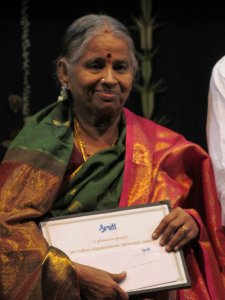 Suguna Purushothaman The prestigious E. KRISHNA IYER MEDAL was presented to 80-year- old Bharatanatyam Guru K Kalyanasundaram Pillai of Sri Rajarajeswari Bharatha Natya Kala Mandir, Mumbai, and the VELLORE GOPALACHARIAR MEMORIAL AWARD to eminent Carnatic vocalist Suguna Purushothaman by Gopalkrishna Gandhi, Chairman, Kalakshetra Foundation. 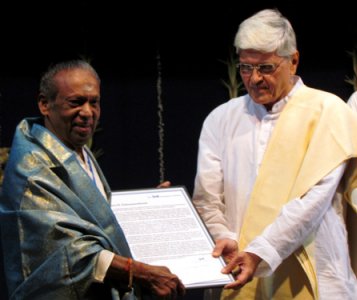 Guru K Kalyanasundaram Pillai & Gopalkrishna Gandhi The award function was followed by an erudite speech by Gopalkrishna Gandhi. Here is an excerpt of what he said. “Sruti is 30, but it reads like a 100 year old. There is something extraordinary about Sruti. It was born with patina on it, like a new shoot with lichen on it, or a fresh print with sepia tint. Some are born wise, with minds developed beyond their age, like Pattabhi Raman was born with a fully loaded microchip of music in his mind. We are celebrating all of Sruti 30 in Pattabhi 80 and all of Pattabhi 80 in Sruti 30. Sruti will remain ever fresh even when chronologically 80 or 100 and will continue to be regarded as the senior journalist of the art world. Sruti has the dilemma of being new but sounding old or being young and seeming ancient. It may have to offend others but defend itself. Sruti has a mandate to hear and see judiciously and not judgmentally. In Sruti’s discriminating readership lies its strength. Each issue is an archive in the making and opens new eyes on an ancient scene. Sruti should remain on the high perch Pattabhi placed it on, then stablised by Ramanathan and now Ramnarayan has infused new energies with his sensitive editorship.” There was thunderous applause! The awardees expressed their thanks briefly. Guru Kalyanasundaram called Gopalkrishna Gandhi’s speech a beautiful margam in itself. His elder brother Mahalingam Pillai had also received the E. Krishna Iyer Medal. Hailing from a family that has been devoted to dance for 300 years, Guru Kalayansundaram is an 8th generation artiste. “Banis may be different but dance is the same. E. Krishna Iyer made many sacrifices to put Bharatanatyam where it is now and I am honored to receive a medal in his name.” Saying so, Guru Kalyanasundaram handed over the purse given to him by Sruti back to Sruti as his donation. Suguna Purushothaman said she started singing for the love of it, but to be recognized for it and bestowed this prestigious award meant she must have done something right! 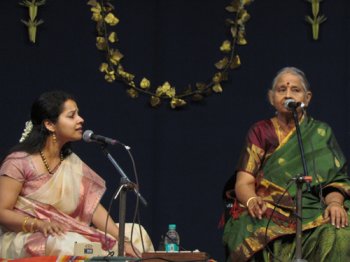 K Gayatri, Suguna Purushothaman
Accompanied by her talented disciple K Gayatri, Suguna Purushothaman presented a special program titled ‘Nuances of the Musiri bani.’ In her younger days, Suguna was giving small lec-dems and concerts and when she finally went to learn from Musiri Subramania Iyer, he was almost retired. His sruti layam gave her “goose bumps” and from him, she learnt how much gamakam to give and where, and one learns that only from hearing. He was very particular about maintaining the purity of the raga. In the Musiri school, it is considered an art on deciding where to sing the neraval. One could call it the nuclear point of a song, where one word or line is sung in different ways with voice modulation. The pause is important and the way the words are split or are joined should make sense and not give the wrong meaning. Musiri was fond of rare ragas like Kokilavarali and was also a great devotee of Thyagaraja. Suguna and Gayatri demonstrated by singing excerpts of songs like “Oh Jagadamba nanu Amba,” “Brovavammaa taamasamele” and the Swathi Thirunal padam “Dani samajendra gamini.” Since she was feeling unwell, she was not at her sparkling best but her simplicity, humility and deference to her guru touched the hearts of the audience. Presented in collaboration with Sangeet Natak Akademi, Delhi, the final evening featured the 3 styles of Chhau – Seraikella, Mayurbhanj and Purulia - by Guru Shashadhar Acharya and his 30 member troupe. The program started with a short film on Chhau that showed the importance of breath control and training in martial arts central to performing Chhau. The majority of the performers are day labourers who dance with joy to forget their mundane existence after work hours. The dance was languishing because of wide spread poverty, but has now been successfully resurrected from near oblivion as more people are being encouraged to take up the art. A short clip of Chaitra Parbha festival, different masks of Seraikella Chhau and how different they are from the masks of Purulia Chhau, the various gurus, some really old, passing on their knowledge to aspiring Chhau artistes, the artistes who are employed as cobblers, farmers, hairdresser and so on, everyday tasks that have inspired various Chhau movements were a good prelude to the audience getting some information on a dance form and its practitioners rarely seen in south India. 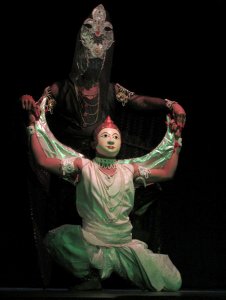 Ratri 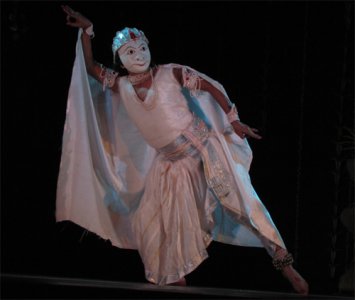 Hamsa 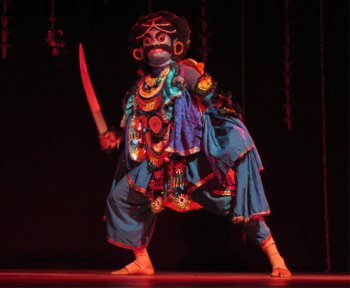 Mahisha 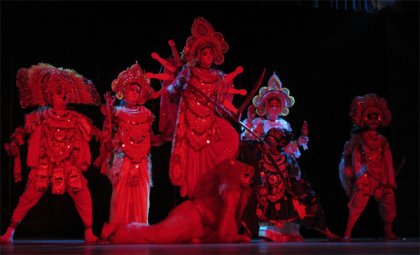 Finale of Durga The program started with a musical invocation in all 3 Chhau styles. Inspired by Ratri Sukta, the famous ‘Ratri’ in Seraikella style based on Vedic concept of celebrating forces in nature had Shashadhar Acharya playing the role of Ratri, an abstract imagery of the night playing with the moon. ‘Radha and Krishna’ was presented in Mayurbhanj as well as Seraikella style. In the former, when Radha is fetching water from the Yamuna River, Krishna breaks the pot by throwing a stone; they quarrel and then make up. In the latter, Krishna’s flute is the focus and Radha learns how to play the flute from Krishna. Both items were so different in style, music and costumes. In ‘Hamsa,’ we got to see the beautifully choreographed movements of the swan in Seraikella style. Conflict in Arjuna’s mind and Krishna’s advice to him during war came alive in ‘Geeta’ performed in Mayurbhanj style. The grand finale was ‘Durga’ in Purulia style. The charming elephant headed god Ganesha, the demon Mahisha in green costume, the Goddess Durga in red with her many hands slaying the wicked demon, all in elaborate head gear, the acrobatic leaps and twirls was such a treat to watch. The percussion and type of music is also different from what Chennai audiences are used to and they just could not stop clapping to show their appreciation for such a colorful evening of dance and music. Shashadhar Acharya is a fifth generation Chhau artiste and he has groomed his sons also into the art. His brothers and sons were part of the troupe. He said that 20 years ago, only about 20 families from the villages were performing, but now at least 200 families from each style had entered the performance circuit and he would work for wider popularity of Chhau. The guest of honor was L Sabaretnam, Chairman, Bharatiya Vidya Bhavan, Chennai. The program was well conducted with S Janaki as anchor person, the stage was decorated with eco-friendly material, and there was a good mix of dance and music. What was disappointing (yet again) was the poor audience turn out. While one could understand that to attend on the first day would have been difficult due to the storm and rains, there was no rain for the next 2 evenings. What happened to all the Sruti subscribers, musicians and dancers, if not general public? After all, Bharatiya Vidya Bhavan is a small hall! Lalitha Venkat is the content editor of narthaki.com |